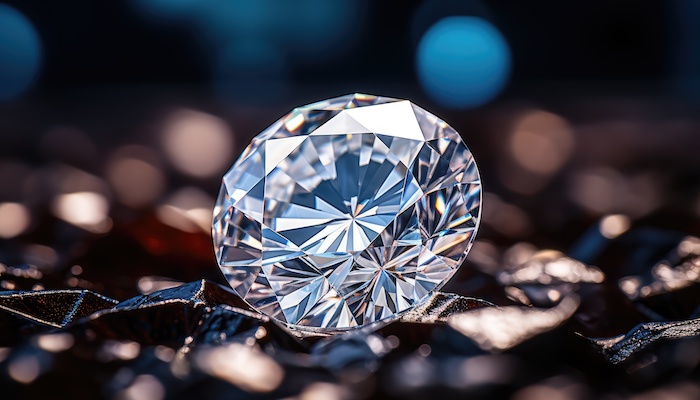A diamond is a solid rock of carbon and the hardest known naturally occurring substance. Because diamonds also have some extraordinary optical and physical properties, intensive research is underway on their use in laser and quantum technology.

Synthetic or lab-produced diamonds have been ‘grown’ for many decades, and the process is exceptional now.
Every natural diamond is different, and can contain many impurities from within the earth, as well as signs of stress which may differ throughout the crystal.
However each synthetic diamond, made under more controlled conditions, is of uniform quality and any impurities can be more carefully managed.
Can you tell the difference between real and lab-grown diamonds?
Synthetic diamonds are chemically and physically identical to naturally-occurring diamonds, and it can be very hard to distinguish them using the naked eye or even with a jeweller’s glass.
Often the only way to definitively distinguish lab-grown from natural diamonds is by using specialist equipment that measures the such as absorption spectroscopy or photoluminescence.
Diamonds that are synthesised for jewellery including extra nitrogen for yellow, boron for blue or silicon for pink diamonds, or by using heat or irradiation treatments.
How are synthetic diamonds grown?
The two main ways to grow synthetic diamonds are the high-pressure, high-temperature method (HPHT) or by using chemical vapor deposition (CVD).
We discussed creating a diamond from Vegemite at one stage – it is technically possible.
In the HPHT method, we place a small fragment of natural diamond to ‘seed’ in a chamber filled with carbon and subject it to high pressure and high temperatures, in a fast-track version of the natural processes that take place over millions of years. The carbon then crystallises around the seed, growing that original diamond by about a millimetre a day.
Then we chop a bit off the new diamond we created for the next seed, and repeat.
The CVD method involves heating a gas mixture of hydrocarbon and hydrogen in a vacuum chamber, causing the carbon atoms to separate from the gas and deposit as a layer of diamond onto a surface. The process can take several hours to create a thin layer of diamond, then repeated to create layers that are many millimetres thick.
Most natural diamonds are between one and three billion years old. They form mainly in old, cold cratons – ancient continental crust structures 150 kilometres or more below the Earth’s surface – where temperatures reach 650 to 1000 degrees Celsius and pressure is up to 100,000 greater than the earth’s surface.
Atoms of carbon then get forced together under extreme pressures and temperatures and bond into crystals which slowly grow over millions of years. These unusual conditions mean that we only ever see diamonds when a volcano explodes, bringing them up to the earth’s surface.
Most natural diamonds pre-date the first land plants, so diamonds are almost always formed from carbonate rocks rather than from compressed coal.
Efforts to synthesise diamonds began after English chemist Smithson Tennant in 1797, and by the mid-1950s scientists succeeded in growing diamonds in a lab. The process has become cheaper and more effective over time.
Advances trigger price drop for lab-grown diamonds
The global market for lab-grown diamonds is growing rapidly, and .
Lab-grown diamonds are typically much cheaper than naturally occurring diamonds, with prices up to 80 per cent lower because they are not subject to supply constraints and the high mining costs of natural diamonds.
The fast-growing market for lab diamonds cut and polished for use in jewellery has seen prices dropping fast; one-carat diamonds from the lab grown diamond company Lightbox (owned by natural diamond retail giant de Beers) were priced at $800 US dollars in 2023.
Australian loose diamond retailer lists a round, ‘super ideal,’ one-carat lab diamond at $1,830 compared with a similar natural diamond priced at $9,435 – more than five times the price.
Diamonds in the lab
Outside the consumer market, however, diamonds have a growing range of uses, with to produce diamonds for quantum computing applications.

The unique properties of diamonds make them ideal for lasers, including their ability to amplify light and deal with almost any wavelength of light (from the terahertz region to the deep ultraviolet), and their superior thermal conductivity which reduces overheating.
At Macquarie University’s Photonics Research Centre, diamond lasers are used for a wide range of research purposes from environmental sensing, to medical and health applications, and even in astronomy, and there is work underway to make diamond lasers of various wavelengths (colours) and scale up the power of diamond lasers.
Diamonds are also being investigated in quantum applications, from developing quantum computers to creating high-resolution imaging systems able to detect individual molecules.
Synthetic diamonds have a very wide range of other uses; for example, there’s now a market for diamonds that are grown from the hair of a loved one or the or a pet.
That’s because a diamond can be grown from any source of carbon, and any organic material, when broken down into its core components. Researchers have made diamonds from all sorts of things – including tequila and even peanut butter.
We discussed creating a diamond from Vegemite at one stage – it is technically possible.
Another important and growing use of synthetic diamonds is as wafer-thin layers that can be applied as a film to cool high-power high-performance electrical components, which generate substantial heat in their use.
Diamonds are also of huge interest as an electronic material for next generation transistor technology – something that is also being researched at Macquarie University.
is a Professor in the Department of Earth and Environmental Sciences and is Associate Dean Research Training and Performance.
is a Professor in the School of Mathematical and Physical Sciences and the Macquarie University Photonics Research Centre.








